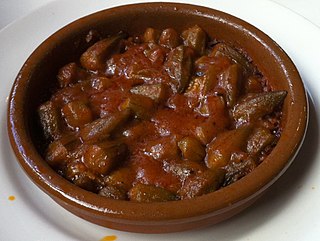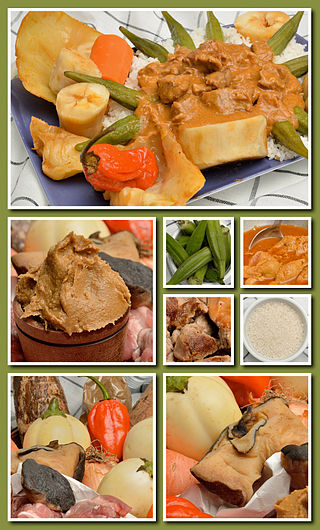
The cuisine of the Southern United States encompasses diverse food traditions of several subregions, including Tidewater, Appalachian, Ozarks, Lowcountry, Cajun, Creole, African American Cuisine and Floribbean cuisine. In recent history, elements of Southern cuisine have spread to other parts of the United States, influencing other types of American cuisine.

Chowder is a thick soup prepared with milk or cream, a roux, and seafood or vegetables. Oyster crackers or saltines may accompany chowders as a side item, and cracker pieces may be dropped atop the dish. New England clam chowder is typically made with chopped clams and diced potatoes, in a mixed cream and milk base, often with a small amount of butter. Other common chowders include seafood chowder, which often consists of fish, clams, and other types of shellfish; lamb or veal chowder made with barley; corn chowder, which uses corn instead of clams; various fish chowders; and potato chowder, which is often made with cheese. Fish, corn, and clam chowders are popular in North America, especially Atlantic Canada and New England.

Braising is a combination-cooking method that uses both wet and dry heats: typically, the food is first browned at a high temperature, then simmered in a covered pot in cooking liquid. It is similar to stewing, but braising is done with less liquid and usually used for larger cuts of meat. Braising of meat is often referred to as pot roasting, though some authors make a distinction between the two methods, based on whether additional liquid is added. Osso buco and coq au vin are well known braised meat dishes, and the technique can also be used to prepare fish, tempeh, tofu, or fruits and vegetables.

Ketchup or catsup is a table condiment with a sweet and sour flavor. The unmodified term ("ketchup") now typically refers to tomato ketchup, although early recipes for various different varieties of ketchup contained mushrooms, oysters, mussels, egg whites, grapes or walnuts, among other ingredients.

Mechado is a braised beef dish originating from the Philippines inspired by culinary methods of Spain, of which it was a former colony. Soy sauce and calamansi fruits are key ingredients to the braising liquid.

The cuisine of the Democratic Republic of the Congo and the Republic of the Congo varies widely, representing the food of indigenous people. Cassava, fufu, rice, plantain and potatoes are generally the staple foods eaten with other side dishes.

Bamia is an Arabian and Central Asian main dish made with okra, lamb, and tomatoes as primary ingredients. It is commonly made in the following countries and cultures: Afghani, Albanian, Armenian, Assyrian, Azerbaijani, Egyptian, Greek, Iranian, Kurdish, Romanian, Somali, Sudanese, Tanzania, and Turkish. Additional ingredients used can include tomato sauce or tomato paste, onion, garlic, cilantro (coriander), pomegranate molasses, vegetable oil, cardamom, salt and pepper.

Peanut stew or groundnut stew, also known as maafe, sauce d'arachide (French) or tigadèguèna is a stew that is a staple food in Western Africa. It originates from the Mandinka and Bambara people of Mali.

Fricassee or fricassée is a stew made with pieces of meat that have been browned in butter then served in a sauce flavored with the cooking stock. Fricassee is usually made with chicken, veal or rabbit, with variations limited only by what ingredients the cook has at hand.

Kho or kha is a cooking technique in Vietnamese and Cambodian cuisine, where a protein source such as fish, shrimp, poultry, pork, beef, or fried tofu is simmered on low or medium heat in a mixture of sugar, and water or a water substitute such as young coconut juice and seasoned with fish sauce or soy sauce and aromatics such as pepper, garlic, shallots and ginger. The resulting dish is salty and savory, and meant to be eaten with rice noodles, baguette, or steamed rice.

Nigerian cuisine consists of dishes or food items from the hundreds of Native African ethnic groups that comprises Nigeria. Like other West African cuisines, it uses spices and herbs with palm oil or groundnut oil to create deeply flavored sauces and soups.

Tunisian cuisine, the cuisine of Tunisia, consists of the cooking traditions, ingredients, recipes and techniques developed in Tunisia since antiquity. It is mainly a blend of Mediterranean and native Punics-Berber cuisine. Historically, Tunisian cuisine witnessed influence and exchanges with many cultures and nations like Italians, Andalusians, French and Arabs.

Chicken mull is a traditional dish from North Carolina, upstate South Carolina and Georgia. It is a type of stew consisting of parboiled whole chicken in a cream- or milk-based broth, butter and seasoned with salt, pepper and other ingredients. Traditionally, the stew is served in the late fall and winter months. In northern Georgia, this part of the year is often referred to as "mull season". Often the term "chicken stew" or "chicken mull" refers to an event or gathering where the dish is served.

A meatball is ground meat (mince) rolled into a ball, sometimes along with other ingredients, such as bread crumbs, minced onion, eggs, butter, and seasoning. Meatballs are cooked by frying, baking, steaming, or braising in sauce. There are many types of meatballs using different types of meats and spices. The term is sometimes extended to meatless versions based on vegetables or fish; the latter are also commonly known as fish balls.

Chadian cuisine is the cooking traditions, practices, foods and dishes associated with the Republic of Chad. Chadians use a medium variety of grains, vegetables, fruits and meats. Commonly consumed grains include millet, sorghum, and rice as staple foods. Commonly eaten vegetables include okra and cassava. A variety of fruits are also eaten. Meats include mutton, chicken, pork, goat, fish, lamb and beef. The day's main meal is typically consumed in the evening on a large communal plate, with men and women usually eating in separate areas. This meal is typically served on the ground upon a mat, with people sitting and eating around it.

A stew is a combination of solid food ingredients that have been cooked in liquid and served in the resultant gravy. Ingredients can include any combination of vegetables and may include meat, especially tougher meats suitable for slow-cooking, such as beef, pork, venison, rabbit, lamb, poultry, sausages, and seafood. While water can be used as the stew-cooking liquid, stock is also common. A small amount of red wine or other alcohol is sometimes added for flavour. Seasonings and flavourings may also be added. Stews are typically cooked at a relatively low temperature, allowing flavours to mingle.

Corn stew is a stew prepared with corn (maize) as a primary ingredient. Many variations exist in ingredient usage and in methods of preparation. Corn stew is a dish in several cuisines of the world. Mazamorra is a historically old corn stew dish in South America that is prepared using simple ingredients, and is a dish in several other cuisines.

















